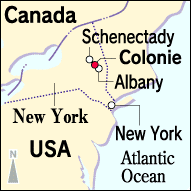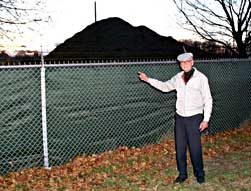  Leonard Dietz: "The US has many nuclear facilities contaminated by
radiation." (Colonie, New York) Leonard Dietz: "The US has many nuclear facilities contaminated by
radiation." (Colonie, New York) |
| Particles drift over 26 miles The clean-up continues |
"These are the remains of the closed factory. The clean-up operation is still underway." Nuclear scientist Leonard A. Dietz (77) points through a fence to a huge pile of earth silhouetted by the evening sun. Six or seven workers inside the fence are raking soil from a deep hole dug with a back hoe. To the southeast, we can still see the towering office buildings of Albany, capital of New York State.
These factory ruins lie in a town called Colonie, on the outskirts of Albany. A company called National Lead Industries (NL) ran the factory for over 20 years, until early 1980. It produced 30mm cannon penetrators under an Air Force contract and dynamic flight control ballast weights for aircraft. The raw material for these products was depleted uranium (DU).
![]() Source discovered immediately
Source discovered immediately
"In 1979, DU particles were found in an air filter monitor ten miles from this factory." After we return to his home in Schenectady, about 20 kilometers (about 13 miles) northwest of the NL factory site, Dietz continues his explanation, referring to a report he compiled himself. At the time, Dietz was a senior researcher at General Electric (GE), where he was a recognized expert in the field of isotopic analysis of uranium by mass spectrometry. His office was at the Knolls Atomic Power Laboratory (KAPL) in Schenectady, which GE ran for the US Navy. He and his colleagues were using mass spectrometers to measure the uranium content in air filter monitors around Navy facilities in the area when they accidentally detected the DU. KAPL did not process DU, so they knew immediately that the particles came from NL. "We monitored a number of checkpoints for five months. We even found them at the most distant checkpoint, which was 26 miles northwest. We found spherical and non-spherical DU particles 4 to 6 micrometers long. You can breathe particles of this size into your lungs."
![]() Submitting the report to the Navy
Submitting the report to the Navy
According to Dietz, the only reason particles were not found at greater
distances was the lack of monitoring stations. He believes that the right
wind conditions would surely spread the particles much further. Dietz compiled
his data in a report and submitted it to the Navy in January 1980.
In early February, less than two weeks after Dietz sent his report to the
Navy, the New York state government ordered NL to terminate operations.
Unrelated to Dietz' study, the state Department of Environmental Conservation
had also been measuring radiation levels outside the plant. They found
that the amount of DU discharged in January 1980 was five times the allowable
state standard (150 microcuries a month).
"One hundred fifty microcuries is produced by 387 grams of DU. NL was routinely discharging far more than that in the form of minute uranium particles," Dietz explains.
![]() Over $100 million for clean-up
Over $100 million for clean-up
NL shut its doors permanently in 1983. The next year, it sold the factory and site to the Department of Energy (DOE) for a nominal fee in lieu of the cost of cleaning up. The full-scale clean-up, including dismantling the buildings and removing contaminated soil, began in 1996. "So far the clean-up alone has cost over $100 million. This is our tax money, you know."
Until he retired in 1983, Dietz was unable to submit his report to anyone but the Navy. He believes that his 1980 report had nothing to do with the closing of the factory, but his investigation increased Dietz' own concern about depleted uranium munitions. In 1991, when he heard that DU munitions would be used in the Gulf War, he immediately protested in the pages of a scientific journal. His article appeared in early February, before the start of the ground war (February 24).
"A 30mm shell contains about 300 grams of DU. The largest 120 mm shells contain about 4.7 kilograms. To protect the health of Americans, we shut down a factory for discharging the equivalent of about two 30mm shells into the atmosphere per month. How can we justify using a million such shells in Iraq and Kuwait, most of it in only four days of war?"
Calm by nature, Dietz is thoroughly convincing as an expert with the figures to back him up.
| Give us your feedback: FAX: 81-82-295-3800 |